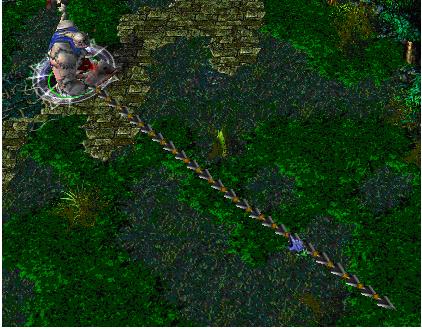Just a Hook
Time Limit: 4000/2000 MS (Java/Others) Memory Limit: 32768/32768 K (Java/Others)Total Submission(s): 38933 Accepted Submission(s): 18894
Problem Description
In the game of DotA, Pudge’s meat hook is actually the most horrible thing for most of the heroes. The hook is made up of several consecutive metallic sticks which are of the same length.

Now Pudge wants to do some operations on the hook.
Let us number the consecutive metallic sticks of the hook from 1 to N. For each operation, Pudge can change the consecutive metallic sticks, numbered from X to Y, into cupreous sticks, silver sticks or golden sticks.
The total value of the hook is calculated as the sum of values of N metallic sticks. More precisely, the value for each kind of stick is calculated as follows:
For each cupreous stick, the value is 1.
For each silver stick, the value is 2.
For each golden stick, the value is 3.
Pudge wants to know the total value of the hook after performing the operations.
You may consider the original hook is made up of cupreous sticks.

Now Pudge wants to do some operations on the hook.
Let us number the consecutive metallic sticks of the hook from 1 to N. For each operation, Pudge can change the consecutive metallic sticks, numbered from X to Y, into cupreous sticks, silver sticks or golden sticks.
The total value of the hook is calculated as the sum of values of N metallic sticks. More precisely, the value for each kind of stick is calculated as follows:
For each cupreous stick, the value is 1.
For each silver stick, the value is 2.
For each golden stick, the value is 3.
Pudge wants to know the total value of the hook after performing the operations.
You may consider the original hook is made up of cupreous sticks.
Input
The input consists of several test cases. The first line of the input is the number of the cases. There are no more than 10 cases.
For each case, the first line contains an integer N, 1<=N<=100,000, which is the number of the sticks of Pudge’s meat hook and the second line contains an integer Q, 0<=Q<=100,000, which is the number of the operations.
Next Q lines, each line contains three integers X, Y, 1<=X<=Y<=N, Z, 1<=Z<=3, which defines an operation: change the sticks numbered from X to Y into the metal kind Z, where Z=1 represents the cupreous kind, Z=2 represents the silver kind and Z=3 represents the golden kind.
For each case, the first line contains an integer N, 1<=N<=100,000, which is the number of the sticks of Pudge’s meat hook and the second line contains an integer Q, 0<=Q<=100,000, which is the number of the operations.
Next Q lines, each line contains three integers X, Y, 1<=X<=Y<=N, Z, 1<=Z<=3, which defines an operation: change the sticks numbered from X to Y into the metal kind Z, where Z=1 represents the cupreous kind, Z=2 represents the silver kind and Z=3 represents the golden kind.
Output
For each case, print a number in a line representing the total value of the hook after the operations. Use the format in the example.
Sample Input
11021 5 25 9 3
Sample Output
Case 1: The total value of the hook is 24.
Source
Recommend
题意:T组数据,N个初始值为1的数,M次操作。每一次操作将区间[x,y]中的数改为z,最后求这N个数的和。
思路:线段树的区间更新基础题,相比较于单点更新,用到了延迟标记。变量看起来有些繁杂...需要改一下代码风格了
#include<cstdio>
#include<cstring>
#include<cmath>
#include<algorithm>
using namespace std;
const int maxn=100005;
int x,y,z,add[4*maxn],n,m;
struct node
{
int l,r,num;
}segTree[4*maxn];
void pushup(int root)
{
segTree[root].num=segTree[root<<1].num+segTree[root<<1|1].num;
}
void pushdown(int root,int ln,int rn)
{
if(add[root])
{
add[root<<1]=add[root];
add[root<<1|1]=add[root];
segTree[root<<1].num=add[root]*ln;
segTree[root<<1|1].num=add[root]*rn;
add[root]=0;
}
}
void build(int root,int l,int r)
{
add[root]=0;
segTree[root].l=l;
segTree[root].r=r;
if(l==r)
{
segTree[root].num=1;
return;
}
int mid=(l+r)>>1;
build(root<<1,l,mid);
build(root<<1|1,mid+1,r);
pushup(root);
}
void update(int root,int l,int r,int c)
{
if(segTree[root].l>=l&&segTree[root].r<=r)
{
segTree[root].num=(segTree[root].r-segTree[root].l+1)*c;
add[root]=c;
return;
}
int mid=(segTree[root].l+segTree[root].r)>>1;
pushdown(root,mid-segTree[root].l+1,segTree[root].r-mid);
if(l<=mid)
update(root<<1,l,r,c);
if(r>mid)
update(root<<1|1,l,r,c);
pushup(root);
}
int query(int root,int l,int r)
{
if(segTree[root].l>=l&&segTree[root].r<=r)
return segTree[root].num;
int mid=(segTree[root].l+segTree[root].r)>>1;
pushdown(root,mid-segTree[root].l+1,segTree[root].r-mid);
int ans=0;
if(l<=mid) ans+=query(root<<1,l,r);
if(r>mid) ans+=query(root<<1|1,l,r);
return ans;
}
int main()
{
int t,kase=0;
scanf("%d",&t);
while(t--)
{
memset(add,0,sizeof(add));
scanf("%d %d",&n,&m);
build(1,1,n);
while(m--)
{
scanf("%d %d %d",&x,&y,&z);
update(1,x,y,z);
}
printf("Case %d: The total value of the hook is %d.\n",++kase,query(1,1,n));
}
return 0;
}




















 357
357

 被折叠的 条评论
为什么被折叠?
被折叠的 条评论
为什么被折叠?








